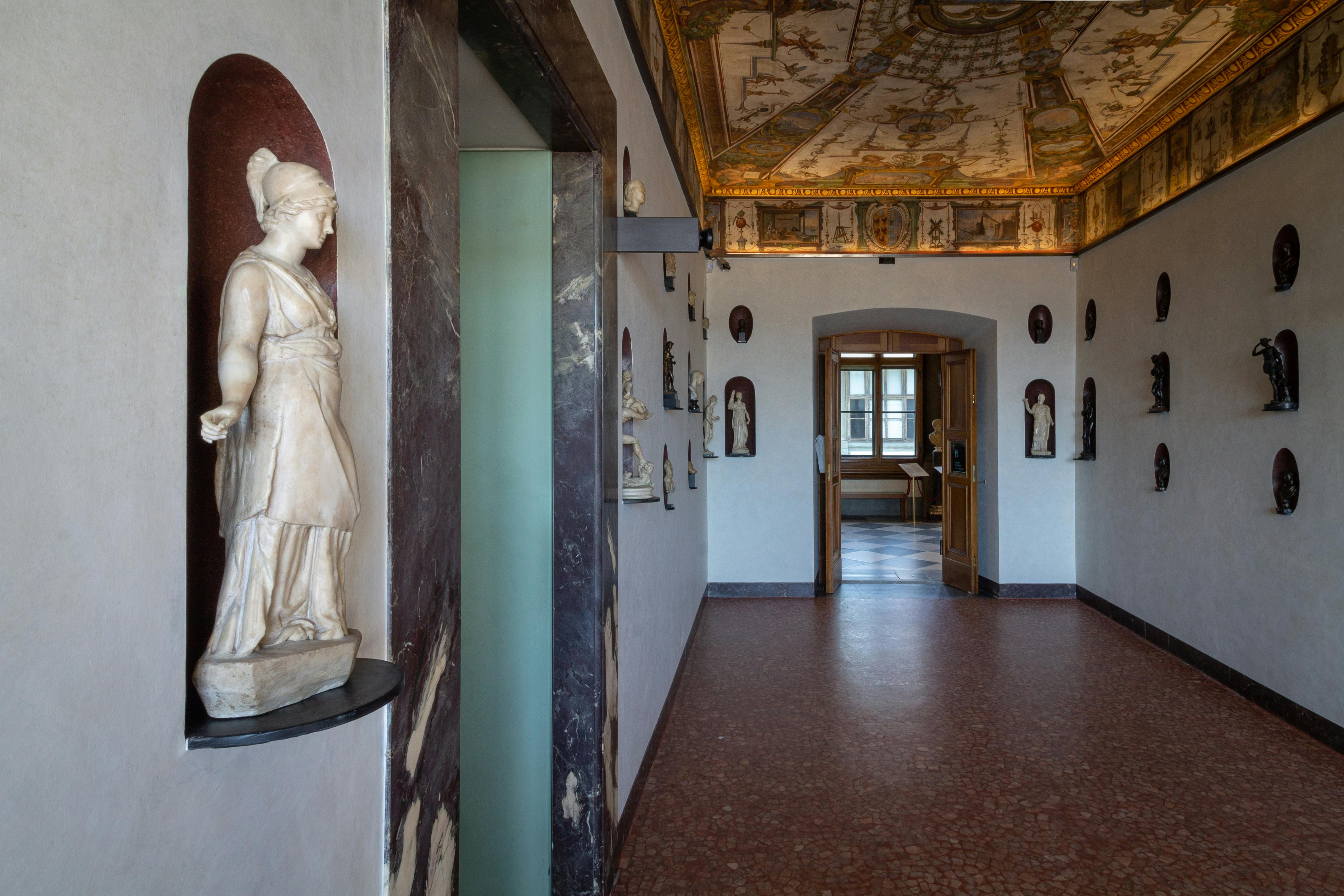New life for the "Stanzino delle Matematiche"
The intimate space beside Buontalenti’s Tribune, decorated with original frescoes illustrating scientific instruments and discoveries, has been completely restored.
Reopened and completely restored to the Uffizi Galleries, the Stanzino delle Matematiche, an intimate space beside Buontalenti’s Tribune, owes its name (“Mathematics Room”) to its original, scientifically-themed frescoes. Given the museum’s commitment to giving visitors an illustration of its evolution down through the centuries, the Stanzino delle Matematiche has undergone operations to restore its floor and walls and to maintain the bronzes housed in its niches, while being endowed with a new lighting system to highlight the details in the paintings decorating the ceilings. The Tribune’s complex restoration, completed in 2012, had essentially turned the Stanzino into one of the observation points looking out onto the Tribune, access to which had been closed for conservation purposes. This space’s antique function was therefore diminished in recent years, during which it served as a kind of antechamber for the Tribune. Lasting about two months and based on stratigraphic assays, the restoration restored brightness to the room with a new, light colouring, while emphasizing the depth of the bronzes’ housings. Curtains were removed and filters installed on the windows to re-establish their relationship with natural light; the ceiling frescoes were enhanced by additional, specially-designed artificial lighting. The operation is part of the museum’s plans to “reassemble” with one another the phases in which a surprising and extremely rich dynastic museum was transformed to become a modern painting gallery.
“For many years after access inside the Tribune was foreclosed for conservation reasons, the room was essentially relegated to the function of looking out onto the Tribune, and the general public no longer had the opportunity to appreciate its originality and value, or to comprehend its important role within the de’ Medici collecting universe,” explains the Galleries’ director Simone Verde. “In its new arrangement, which also enhances its treasures, the Stanzino bears exemplary witness to how the tree of all European museums grew from the Uffizi Galleries, and to the close bond between this space frescoed with the instruments of science, the nearby Terrace of the Map Room and the Hall of Geographical Maps in the Palazzo Vecchio. In its 18th-century transformation into a space for the display of antiquities, it also testifies to the transition from a 16th-17th-century model to a cornerstone of European antiquarianism.”
THE STANZINO: SOME HISTORY
In this space, Grand Duke Ferdinando I de' Medici (1549-1609) had set up the collection of scientific instruments begun by his father Cosimo I (1519-1574). The Stanzino delle Matematiche, or the “Mathematics Room,” was conceived to house “technological” devices, treatises on various subjects pertaining to the Sciences, maps, city plans, and wooden models of war machines and fortifications. The ceiling was frescoed between 1599 and 1600 by Giulio Parigi (1571-1635), with grotesque decorations whose numerous panels depict scenes illustrating famed ancient and modern inventions. The depictions celebrate Pythagoras, Ptolemy, Euclid, and especially Archimedes: the codex of his works now conserved at the Laurentian Library came to Florence during those years. The Medicis were known supporters of the sciences and of Galileo, who dedicated his Sidereus Nuncius to Cosimo II de’ Medici. Galileo was also celebrated as the “new Archimedes” in the frescoes in the Gallery’s West corridor. The Terrace of the Map Room (Terrazza delle Carte Geografiche) was linked to the Stanzino delle Matematiche as well. Itself completely restored in recent times, it too bears testimony to the Gallery’s ancient, universalist vocation. The Stanzino delle Matematiche also houses a unique collection of small, ancient and Renaissance statuary placed in a series of niches created in the years of the Tribune’s radical rearrangement carried out between 1780 and 1782 under the guidance of the abbot Luigi Lanzi. The most precious works, conserved until that time on the shelves of the Octagonal Room (at the end of the First Corridor on the Gallery’s second floor), were placed in the Stanzino until, during the 19th century, the niches were closed. Rediscovered in the 1960s, they were “repopulated” only to a minimal degree with the works once held in the Tribune. The precious, small 16th-century bronzes by Willem van Tetrode, originally destined to adorn a majestic medagliere and donated to Cosimo I de’ Medici by Gianfrancesco Orsini in 1562, were instead housed in this space: in the Stanzino, they offer a rich repertoire of the most renowned ancient sculptures known in 16th-century Rome.

